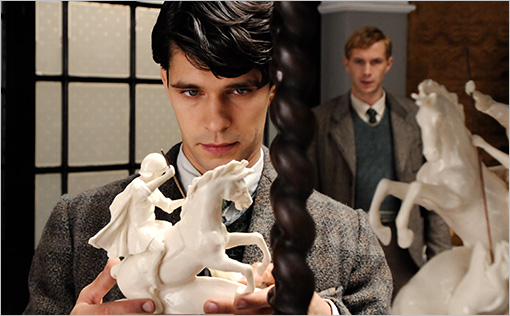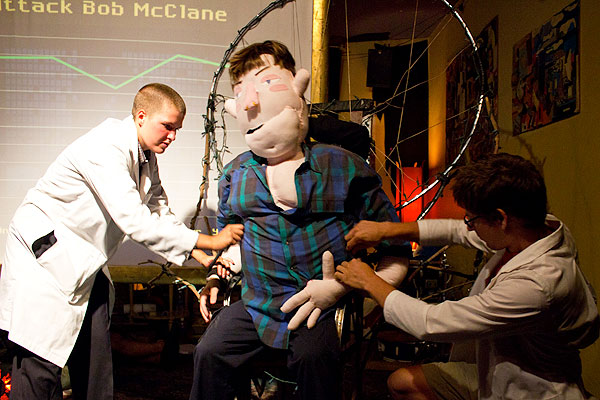Space Jam
For those lucky few living in Chicago, where everything that ever happens happens (eat your heart out, Mr. Kitchell), note that, this weekend, Landmark’s Century Cinema is digitally projecting midnight screenings of Space Jam, yes, Space Jam. I mention this because I really want to direct your attention to Michael Castelle’s write-up on the film, courtesy of the weekly movies email Cine-File (which is well worth subscribing to):
While conventionally considered a film of little theoretical interest, former Chicago gay rights activist and linguistics professor Michal Brody has cogently argued (in the proceedings of a 2001 conference) that Space Jam bears many unusual correspondences to the thousand-year old Popol Vuh mythology of the Quiché Maya kingdom (now the highlands of western Guatemala). Consciously or unconsciously, the film’s writers have developed a narrative in which a pair of heroes (Bugs Bunny and Michael Jordan) 1) are summoned to play a high-stakes underworld ball-game against a variety of frightening villains, 2) manage to defeat those villains through the heroes’ summoning of extra-human ability, and 3) ascend from the underworld with a glowing orb, all of which occur in the Popol Vuh. While the details vary (in the Popol Vuh, the heroes intend to retrieve the head of their father, Hunahpu; whereas in Space Jam, the villains have stolen the talent of NBA stars such as Charles Barkley and Patrick Ewing), the congruence is remarkable. Brody also shows that the well-known phonetic irregularities of, e.g., Daffy Duck and Sylvester are quite analogous to those of ancestral characters in a variety of native cosmologies. Otherwise best known for its perpetuity of wince-inducing composite effects work and the controversial, heteronormative “Lola Bunny” subplot, the film additionally includes the R. Kelly quiet-storm ballad “I Believe I Can Fly.”
Brody’s 2001 paper on the topic (“Invoking the Ancestors: Edward Sapir, Bugs Bunny, and the Popol Vuh”) is here (PDF).
I will now leave you with the obligatory link to the original Space Jam movie website.
Freedom [2010]
Online performance in a war videogame in which Eva Mattes tries to make an artwork and pleads not to be shot, only to always meet a violent death.
25 Points: Cloud Atlas
1. Dear God did I want to like this.
2. I’m something of a fan of the Wachowskis. Bound and Speed Racer are fun, and I adore the Matrix Trilogy (yes, even the sequels). And I have nothing against Tom Tykwer, either. I enjoyed Run, Lola, Run, and admired his stab at making a Kieslowski (Heaven). I wish there were more filmmakers out there like the three of them.
3. Cloud Atlas is pretty well-directed. It presents six different plots across six different timelines, and (speaking for myself) it was easy to follow, narratively. That’s not nothing.
4. I’ve long argued that Titanic is a very well-made film. It’s three hours long, with dozens of characters, and it never becomes confusing, never drags.
5. This will not be the first time I compare Cloud Atlas with Titanic.
November 26th, 2012 / 8:01 am
Fans of artistic exploitation/transgressive cinema should check out the site Moondog Madness, where among other things you’ll find posts on Nick Zedd (including some news about his new film, Love Spasm, and an old trailer for War Is Menstrual Envy), and a detailed obit for Kōji Wakamatsu.
I’m sorry, Mario, but your cultural critique is in another castle: some thoughts on hipster irony
Last August I attended a live reenactment of Total Recall (the classic 1990 version, natch, not the remake). It was a deliberately shambolic affair, a loosely-focused variety show run by Everything Is Terrible and Odds N’ Ends, involving puppets, videos, intentionally bad acting, and dancing. It was, I suppose, what some would call “hip” or “ironic.”
At one point we watched a reedited version of one Total Recall‘s many chase scenes—the infamous escalator shootout where Arnold uses a bystander as a shield—now set to Drowning Pool’s “Bodies.” (You can watch the video here.) Which is about as cliched as it gets, but it totally works as comedy.
Part of what makes the video funny is that the Everything Is Terrible folks have upped the intensity of the Drowning Pool song: “Let the bodies hit the floor, let the bodies hit the floor … Oh, wait, they’re totally stepping on that dead guy’s squishy body—ick.” Here we must pause responsibly to acknowledge that Drowning Pool frontman David Williams has always stated that the song is not actually about “the violence thing,” but rather the “respect and code” of the mosh pit, or some such other bullshit. That hasn’t stopped Hollywood folk from using the song in numerous action movie trailers. Nor has it deterred legions of Drowning Pool fans from making their own YouTube versions.
In other words, the Everything Is Terrible video’s ironic effect depends on the pairing being a cliché. Like a lot of satirical and ironic art, it proceeds by imitating an otherwise naïve or sincere effect, then subverting it. (This is why “irony vs. sincerity” is often an unhelpful binary when thinking about phenomena like hipster irony or the New Sincerity; those scenes or movements aren’t strict artistic opposites, since they necessarily share a lot of their aesthetic maneuvers. Where they differ usually lies more in their degree of self-effacement, and in their authorial intention.)
Hipster irony is commonly perceived purely as dismissal: “You’re just making fun of Drowning Pool.” And there’s certainly truth in that—fuck Drowning Pool! But is that all there is? Because the EIT video, I think, and the entire Totally Recalled show, could be perceived as something more. Those behind the show, and those in attendance, I’d argue, were actually trying to appreciate “Bodies”—but in the only way they now can. Irony, in other words, allows hipster audiences to make use of material that would otherwise be off-limits to them.
It won’t surprise you that I want to turn here to Viktor Shklovsky, because he identified a concept that I think might help us. It is his concept of deterioration:
Seated Man

Ingres’ The Valpinçon Bather (1808) was originally known simply as “Seated Woman,” but was eventually come to be known by one of its 19th century owners Valpinçon, a bow to patronage’s constant finger in history. The painting may be seen as a more mature and restrained follow-up to Woman Bathing (1807), whose side-view titty shot and pronounced sexual imminence is argued, with many others like it, to have been the porn of that day. With the Valpinçon version, we only have the plush concavity of the sheets, barely burdened by her, caving in to her calm neutrality. Whether she looks elsewhere, or concedes to our gawk, is unknown. Baudelaire is to remark on her serene chastity, a contradiction to the overt sexuality of the rest of his female subjects. We are taught what is extreme by the very boundaries meant to be straddled, us sliding down the wrong side. Pornographic images essentially commemorate that such events actually happened; the fantasy is not contingent on its possibility, but actual manifestation. (I am a keen on outdoor sex by railroad tracks, preferably in Eastern “fallen” Europe, or the Balkans, whose culmination requires paper towels that are never around.) Shame (2011) follows an emo sex addict with a python dong who likes to jog to Bach and breaks down and cries, all under the Picasso blue period tint of lower Manhattan. He follows women home from the Metro and fucks them in the presumable pooper. He slams them against the glass wall panels in lush condos overlooking the Hudson. Through a disappointing homophobic lens, to convey just how fucked up he has gotten, our protagonist (Michael Fassbender) gets punched in the face and winds up in mysterious “gay underworld” lit by fuchsia lights, blowing or being blown, the up-close crooked handheld camera mimicking head bobbing motions. The secret to this laptop, and yours, is before facebook, nytimes, and weather channel, it’s the sad honesty of complete strangers fucking with more feigned professional conviction than real relationships could ever propose, or would ever dare to. This is the beauty of our kidnapped gaze. This morning, my legs splayed across a black Pier 1 dining chair, I saw a Japanese girl blow a fisherman (yeah, right) in the bait shack, his resuscitated dong under the costume of scintillating pixels, her lips exposing each solemn purple inch as she slowly withdrew with his child in her. Sex addiction is like saying food addiction: the biological need can easily justify the adandoned insanity of its consumption. My favorite scenes were of Fassbender on his pristine bed, the minimalist camera trusting the viewer enough to barely move, stoically wanking it to his black Dell laptop, whose averted screen, like Valpinçon’s face, begins to tell the story of what can’t be told.
Q & A WITH TODD GRIMSON
Todd Grimson is one of the great living cult novelists. I’ve known him for a few years, under strange circumstances. He wrote Brand New Cherry Flavor, which is both one of my favorite horror novels and my favorite novel about Hollywood and the film industry. He also wrote the underground vampire classic Stainless. Both were recently re-released by Schaffner Press, which is now publishing his new collection of stories, Stabs at Happiness, in pleasing hardcover.
It’s a terrific collection, diverse and weird and disturbing. (Here are some reviews: Litbitch. The Oregonian. Gothic.net.) You can and should buy it.
I asked Todd some questions about Stabs at Happiness and about his strange life and career.
For a while, you assumed the name “I. Fontana” and published stories in BOMB, Juked, The Quarterly, Lamination Colony, Word Riot, PANK, the Voice Literary Supplement, Bikini Girl, Spork and many others. We corresponded for some time before I knew your real name. Why did you adopt that name?
Fontana comes from “Fontana Mix,” a composition by John Cage I heard when I was 13. READ MORE >
The Zachary German Documentary, “Shitty Youth”
Zachary German’s web presence was one I once compulsively checked-on for updates, that I consistently enjoyed, intriguing and funny, and now his web presence is gone, mostly, because he wanted it to go away.
Adam Humphreys’s new documentary, Shitty Youth, which shares a name with German’s possibly defunct “radio show”/podcast, portrays German as a willfully difficult or potentially alienating person socially who is very attuned to style and taste, the author of one novel, Eat When You Feel Sad, which got good attention and praise, who has released almost no writing since, in part because much writing, including his own, is not up to his very high standards.
November 5th, 2012 / 5:54 pm
Shitty Youth has been released
Last night Adam Humphreys released Shitty Youth, a 36 minute film following Zachary German, who most of you are likely familiar with, on Vimeo through the film’s Facebook page. The film follows Zachary for two years following the release of his first novel Eat When You Feel Sad and features interviews with Tao Lin, Brandon Gorrell, Steve Roggenbuck and myself.
Now we can all die.
Pasolini: Observations on the Long Take
I’ve been thinking about the cinematic long take a lot lately. I’ve always been obsessed with the long take. Among my favorite directors are Tarkovsky, Pasolini, Wong Kar Wai, Tsai Ming-liang. And lately I’ve been watching Bela Tarr on repeat. Like all his films over and over again, because I’m convinced that his use of the long take is accomplishing something very different than these other directors, a sort of reaching of a moment of clarity that results not in understanding but something else. Maybe something like the feeling of intimacy and claustrophobia and fear and relief that comes with giving a confession. Anyways, more thoughts on this coming soon. In the meanwhile, I wanted to post up Pasolini’s great essay on the long take. It framed a lot of thinking about the long take in film, what it means, etc. Sharing the essay with you below…

Werckmeister Harmonies dir. Bela Tarr
***
Observations on the Long Take
By Pier Paolo Pasolini
Translated by Norman MacAfee and Craig Owens
. . . .
Consider the short sixteen-millimeter film of Kennedy’s death. Shot by a spectator in the crowd, it is a long take, the most typical long take imaginable.
The spectator-cameraman did not, in fact, choose his camera angle; he simply filmed from where he happened to be, framing what he, not the lens, saw. [1]
Thus the typical long take is subjective.
In this, the only possible film of Kennedy’s death, all other points of view are missing: that of Kennedy and Jacqueline, that of the assassin himself and his accomplices, that of those with a better vantage point, and that of the police escorts, etc.
Suppose we had footage shot from all those points of view; what would we have? A series of long takes that would reproduce that moment simultaneously from various viewpoints, as it appeared, that is, to a series of subjectivities. Subjectivity is thus the maximum conceivable limit of any audiovisual technique. It is impossible to perceive reality as it happens if not from a single point of view, and this point of view is always that of a perceiving subject. This subject is always incarnate, because even if, in a fiction film, we choose an ideal and therefore abstract and nonnaturalistic point of view, it becomes realistic and ultimately naturalistic as soon as we place a camera and tape recorder there: the result will be seen and heard as if by a flesh-and-blood subject (that is, one with eyes and ears).




